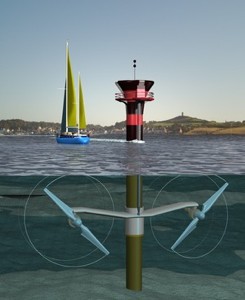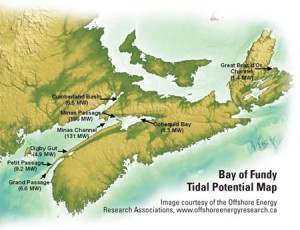January 25, 2014 – May the FORCE be with you. FORCE is an acronym for the Fundy Ocean Research Centre for Energy, a research facility focused on tidal energy technology.
If you are not familiar with the Bay of Fundy, it is home to the highest tides in the world. Lying between two of Canada’s Atlantic provinces, Nova Scotia and New Brunswick, unless you have visited its shores its impossible to describe how significant the ebb and flow of water really is. Back in 1980 my wife and I stayed in Digby, Nova Scotia and went for a walk at low tide out to a wreck almost one-half mile from shore. When the tide turned it kept pace with us as we walked back to higher ground. When we turned to look at the wreck we had visited it virtually had been swallowed by the rising water.
Each Fundy tide displaces 160 billion tons of water, more than all the water flowing in rivers and streams around the world. Few other places in the world can match it. And the potential from the movement of this kind of volume of water has attracted developers with underwater solutions to convert the ebb and flow to marketable energy.
In December Black Rock Tidal Power, DP Energy, and OpenHydro all applied to demonstrate their concepts for tidal energy generation. They join MinasEnergy and Atlantis Resources, two others who have been testing technology in the Bay of Fundy.
Tidal turbines work like underwater windmills. The movement of the water causes an impeller to rotate which is connected to a turbine which in turn is connected to an electrical generator. Each of the companies takes a different twist on the design of their impellers. For example, OpenHydro encases its impellers in ducts to escalate waterflow and increase efficiency. Marine on the other hand uses dual reversing pitch propellers that resemble wind turbines. You can see an artist rendering in the image below.
The technology needs to operate over a range of tidal conditions and water movement that varies from o to 15 kilometers per hour.
Back in December FORCE marked the first successful installation of a subsea cable in the Minas Passage, at a narrowing in the Bay visible on the above map. Installed during a blizzard that swept over the Bay, this cable installation will give FORCE the means to analyze data in real-time from its Fundy Advanced Sensor Technology (FAST) platform, a submerged set of instruments designed to gather detailed knowledge about the many subtle characteristics of Fundy’s incredible tides. Eventually the government of Nova Scotia, which funds FORCE, will announce one or more winners among these competing technologies and the experience of installing the cable will prove useful when subsea power cables get attached to these new energy generators.













